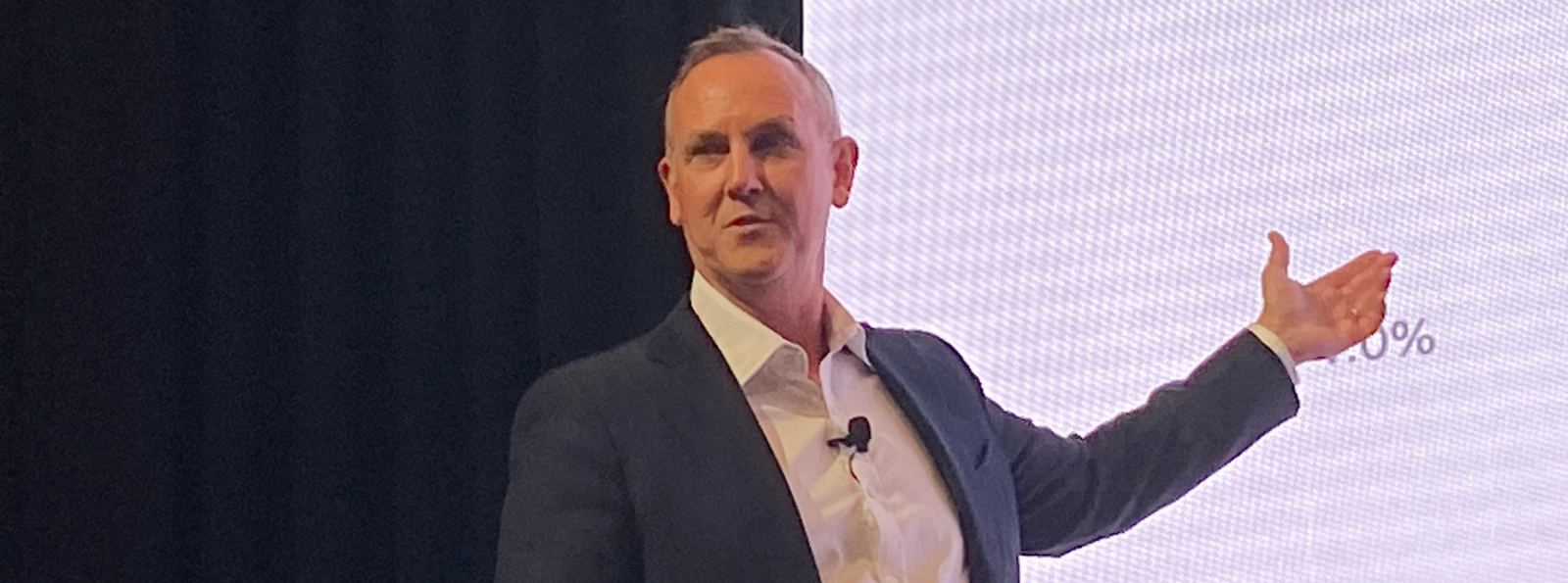Christopher Joye and Andrew Lockhart duel over finance's biggest question
It is, without doubt, one of the biggest unanswered questions that exists in financial markets today. Is the private credit asset class about to face a reckoning?
Its critics, one of its loudest being Coolabah Capital Investments CIO Christopher Joye, say that it is untested in an interest-rate default cycle and that its bad actors make it "the new junk loan market".
Its proponents, one of its loudest being Metrics Credit Partners Managing Partner Andrew Lockhart, argue that it is a victim of people who simply tar all private debt with the same brush and are jealous of its immense growth.
So who's right? To find out, Lockhart and Joye duelled in front of a jam-packed room of financial advisers and investors. Livewire was the only media outlet in the room and this wire brings you the highlights of a conversation that is well worth reading to the end.
The Roast: Returns vs Growth
Two key themes came up in the preliminary "roast" segment - that public bond investments have not delivered for investors and that for all its flashy yields, private credit firms run "black box portfolios" that often have little transparency and, hitherto, no concrete local regulation.
In his opening remarks, Lockhart flat-out questioned why anyone should be invested in any bonds given the last 10 years' worth of returns.
"For most investors, I would genuinely ask - why do you need to take on market risk in a fixed income portfolio, why do you need to take interest rate risk in an investment portfolio, why do you need to take currency risk into a portfolio, why do you need to pay higher fees when you can just be in passive investments?" He said.
.png)
Joye agreed while clarifying that the worst-performing investments have been a result of the interest rate environment.
"The more general observation that [Lockhart] made, which is that active bond managers have done poorly is 100% correct. I honestly think you'd be better in passive ETFs and private debt than being with most active managers. But if you look at the outright level of yields right now, floating-rate yields are attractive, fixed-rate yields are attractive, and some spreads are attractive. I wouldn't touch the hybrid market right now," he added.
.png)
Lockhart, in response to criticisms that private credit markets are in a valuation bubble, simply replied that there is a huge, unfulfilled need for debt out there and that there needs to be an avenue for non-rated companies to access funding where appropriate.
"Most Australian companies don't have credit ratings. Most Australian companies can't access alternative institutional bond capital. Bonds are not flexible instruments that cater to the financing requirements of most companies. You can't build a 30-story apartment tower with a bond as your financing arrangement. It doesn't work," Lockhart said.
"I think the demand for private credit will continue. It's not an asset class where you're the lender of last resort. The companies we lend to couldn't easily go and get financing from the banks. It's about creating value for those companies to drive value and growth for their shareholders and to actually contribute to the success of our economy," he added.
Valuations: Genuinely difficult to work out or bogus?
One of the biggest question marks surrounding the private credit space is around valuations. In public markets, credit spreads, bond yields, and ratings are all available to those who want to access (and pay for) it. But, of course, in private markets, no such barometers exist publicly, as of yet.
So how do you possibly gauge valuations in a market where every loan, every company, and almost every situation is different?
Lockhart offered the following:
"Credit spreads being wider in one asset class, I don't think, is going to make one scrap of difference in terms of the attractiveness of the returns we deliver to our investors," Lockhart said.
"When you originate a transaction, markets are competitive. When you're pricing a loan, you're pricing it on the basis of the alternative ways in which borrowers can access that debt. Have they got an option, for instance, to issue a bond? Could they go and raise money in an offshore market? Can they raise equity?"
"The biggest risk to private credit valuations isn't actually a mark-to-market adjustment. It's the risk of any impairment and the potential risk of loss that would impact a loan portfolio," he added.
Joye, who has long been vocal about some of the valuations in asset classes like real estate, remains adamant that the biggest concern is the lack of transparent data in the emerging asset class.
"Managers are not disclosing delinquencies, arrears, LVRs. They're not disclosing the types of loans that are in the portfolio, what's interest-earning and what's not. They're not disclosing restructurings," he said.
"I think private credit is eventually going to be forced to do this. But I think you're going to see so many misrepresentations. Again, fund managers are saying everything's fine but suddenly they're taking a write-down or suddenly disclosing large delinquencies. The longer that rates remain high, the more likely we're going to see problems of this kind," Joye added.

Lockhart fired back, arguing Joye is spreading misinformation around intentionally incorrect valuations and called out a misnomer Joye had mentioned in a previous segment about AustralianSuper's $1.1 billion loss on a private markets investment was not reflective of private debt, but rather of private equity.
"If you're an owner of a property and you're the equity holder of that, then chances are you're not going to test the market. You haven't got an alignment with the interests of your investors. You want to hold the asset for as long as you can and time the exit and they are genuinely illiquid," Lockhart said.
"The idea that this presents some risk is not quite right. At the end of it, a loan should be a case of 'If I lend a dollar today, then I should receive the interest and fees and be repaid my dollar at the end of the term. And if I haven't, then I've got an impaired loan and there's a risk of loss."
Offshore vs domestic opportunities
At this point, the conversation diverges a little into Australia versus offshore. Coolabah, which manages both local and global bond strategies, spoke to why they have been playing in Australian credit assets over the past six months.
"Aussie bonds have actually offered additional spread over identical bonds in different currencies around the world," Joye said.
"Normally, Aussie bond [spreads] trade tighter. Major banks normally trade on tighter spreads in Aussie dollars relative to where they trade in US dollars, Sterling, or Euros. But in the last six months, we've seen periods where we've actually got superior spreads on Aussie credit."
In other words, the best money of late has been in our own backyard.
When it comes to private markets, Australia is unique in that an overwhelming majority of loans and corporate activity is still controlled by the Big Four banks. Lockhart explained the implications of that for private debt investors like him in the following:
"Most Australian companies don't have too many alternatives in terms of where they go to get their financing and they are heavily reliant on the banks for funding. As a result of that, you've got very attractive risk-adjusted returns that are generated in Australian private debt," Lockhart said.
"And then at the same time, you've got this situation where the banks are being impacted by regulatory change and that sees them move out of certain markets because the cost to carry certain assets on their balance sheet becomes quite punitive and they can't generate the required returns for shareholders. That liquidity withdrawal means that creates an opportunity for those that can identify that and originate good credit transactions."

On risk and liquidity premiums
Joye and Lockhart were also asked how many basis points investors should be asking for to take on the risk of sub-investment grade debt (in public markets) or a private markets investment.
Joye's theory is based on where you start. In his case, it's bank hybrid bonds, which normally have a premium equivalent to 350 basis points above bank bills. For private markets, he argued, "you probably want 100 to 200 basis points of liquidity and premium above and beyond that 350 basis points through the cycle level to compensate you for the inability to trade."
Lockhart sees things, unsurprisingly, quite differently.
"The research I've seen suggests that it's 300 to 400 basis points of wider private markets compared to public markets," he said.
"But it's not so much an illiquidity premium in our mind as it is more a function of the manager's skill set to originate good quality transactions."
And finally...
In a final twist to this debate, it turns out that for all of Joye's reservations about private credit (and even a relative getting burned by one such investment, a story you can hear about here), he has actually added some of his mother's money back into private credit exposure (through buying Soul Patts, which has a credit portfolio in its investments business.)
Interestingly, when asked by a member of the audience if Lockhart would invest his own mother's money into one of Joye's funds, Lockhart was left decidedly red-faced before admitting:
"Chris has obviously got great products and it caters to a market need. For me, personally, I would need to do the research and due diligence."
That got a rise out of the audience - and probably left its anonymous question submitter feeling very smug.
Now, it's over to you!
I enjoyed hearing from both Joye and Lockhart in the room. The debate proved not just why private credit is gaining so much interest and traction, but how much further it may have to go to stand equal alongside its public peers. It was also great to see the "roast" section bring one of the market's most reserved investors (Lockhart) a little bit out of his shell - and I mean that very sincerely!
But now, it's over to you. Who do you think won the debate? Vote in our poll below and let us know what you think in the comments.
4 topics
2 contributors mentioned

